
A lot has been made of Drew Brees’ arm strength and the New Orleans Saints offense, but they’re sitting at 3-2 and are right in the thick of things in the NFC South. They’re scoring 30.6 points per game, and while there is a lot of short game and possession passing in the Saints offense, they also attack the intermediate middle of the field with deep digs and crossers in the Dagger and Y-Cross concepts. These those two schemes are very similar to each other and also work to open up space underneath for Kamara on check downs. Nothing is really new under the sun for NFL teams and passing schemes. Almost every team uses some variation of the big concepts like Drive, Shallow Cross, Stick, Mesh, or Dagger, but the inventive coaches find ways to tweak them, make them look different, disguise them so defenses can’t key on them, and even combine multiple concepts into one play; and that’s what Sean Payton does a good job of.
Note: If you prefer to watch a video breakdown, scroll to the bottom of this article.
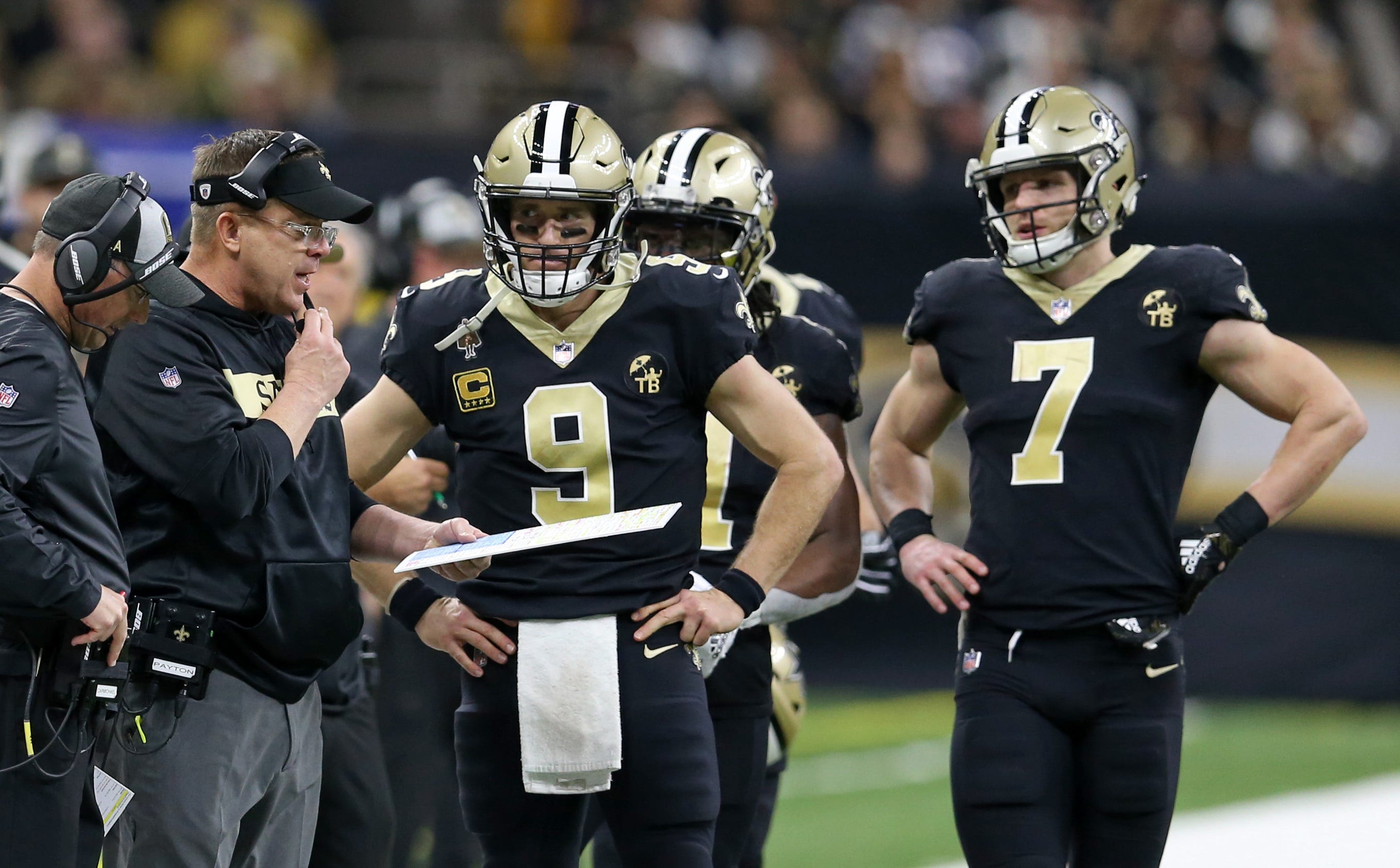
First, let’s understand the Dagger concept. Dagger uses a clear out with a deep dig behind it and typically a shallow drag or someone in the flats underneath it to give a high-low read on the defense. Dagger can be incredibly effective against any coverage. Its one downfall though, is that the primary read and goal of the play – the deep dig – takes a long time to develop so it puts a big burden on the offensive line. With the deep dig to attack the middle of the field, you’ll often see it called in 2nd or 3rd and long situations where you’re more likely to see two high safeties and softer coverage. That’s exactly what we have here with a 3rd and 15 for the Saints. Here, the Packers are in match cover 4. What that means is that for all intents and purposes, the deep routes are covered in man. Match coverage uses a lot of man on demand or MOD coverage. If the receiver lined up on the corner goes vertical, the coverage turns into man. If that receiver goes inside within five yards, the corner would pass that route off to the linebacker. This also applies to the nickel corners here lined up over the #2 receivers. If their receiver goes vertical, they carry. If they go inside under five yards, they pass it off. You can see just that at the top of the screen as the tight end Jared Cook immediately goes inside and the corner passes him off the linebacker while pointing and communicating an “in” call.
The safeties meanwhile, are giving support over the top and helping to bracket routes inside and out. You can see that the safety to the bottom of the screen quickly bails to the outside to bracket the receiver to the outside while the nickel carries him from the inside. Kevin King on the other side of the field is running a lock call so no matter what, he’s man on that receiver. This frees up Adrian Amos to peak and lean to the field side and help down the middle. This is exactly what the Dagger concept can exploit. Remember, we have a clear out with a seam or a skinny post from the play-side slot receiver. This receiver needs to get inside of the safety to his side so that he pulls him in coverage. The more people he can take with him on this route, the better. On the outside, we know that in match cover 4, the corner is going to be MOD on the dig because it’s deeper than five yards. So, we’re clearing the nickel corner and play-side safety and now have a one-on-one with the corner on the outside. Meanwhile, from the backside of the play, we have that shallow drag coming across the field. We talked about that being passed off to the linebacker and that’s exactly what happens. It keeps the linebacker underneath to open the window for the deep dig behind. It all works perfectly – except for protection starts to break down and Brees can’t hang in the pocket long enough to hit the dig as it’s breaking open. What the route concept has done though, is left Kamara one-on-one in the open field against that dime corner that passed off the shallow drag. A matchup that the Saints love every day of the week. It might be a dump off and check down off of a deep play concept, but it picks up the 15 yards on 3rd and long and moves the chains because it has stressed the defense vertically and opened space underneath.
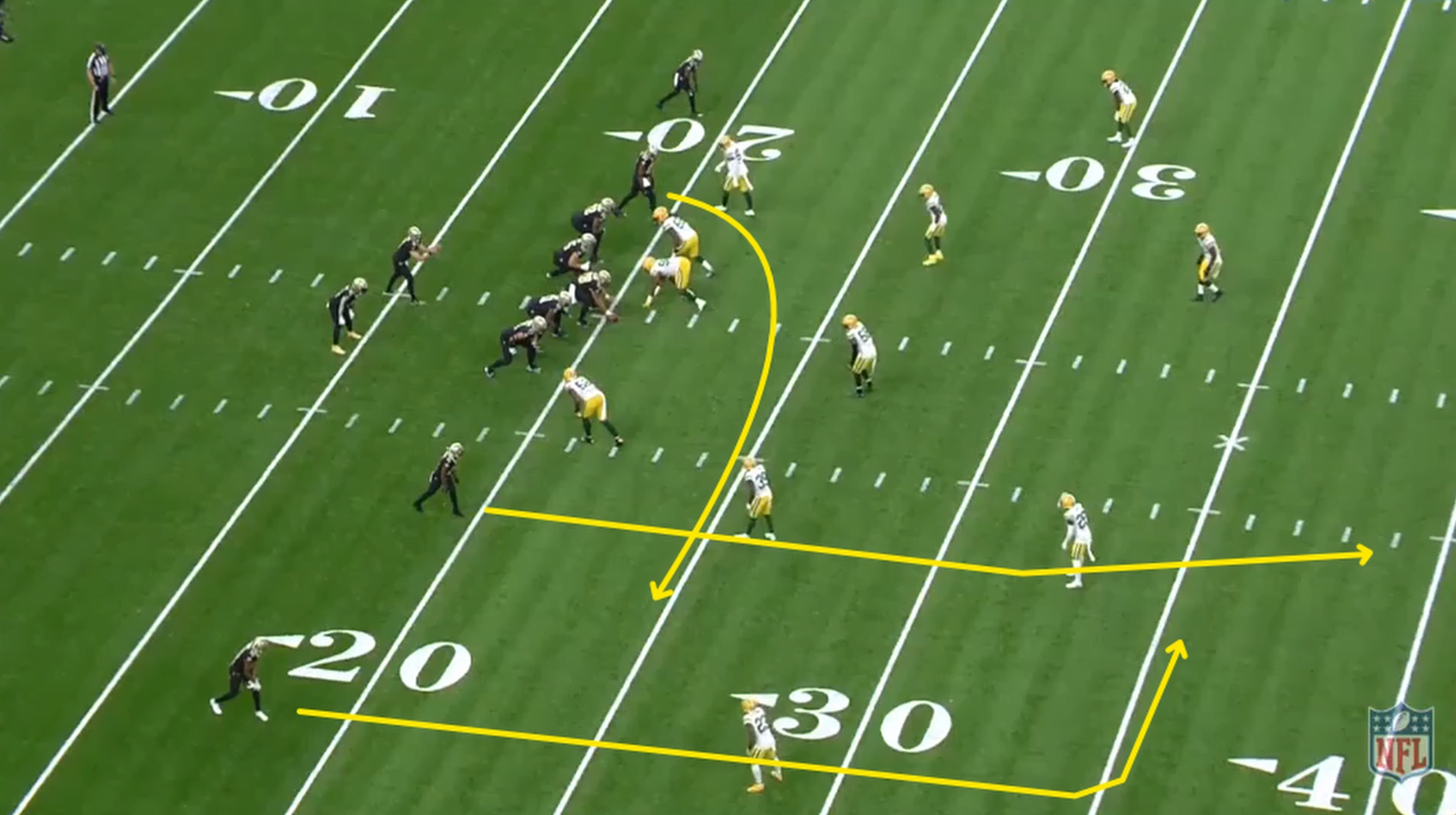

Dagger is still really effective against a single high safety look as well. The purpose of the clear out is exactly the same. His job is to hold that safety with his seam route and pull the corner with him to clear space underneath for the deep dig. The Raiders are bringing extra pressure here so the middle of the field is really open but that means the running back has to stay in to help with the blitz so there is no outlet for Brees now. He’s going to have to stand in the pocket until the dig develops or until the shallow drag pops open. What’s great about these tight splits when running Dagger is that the deep dig gets inside leverage on that cover 3 corner which makes life a lot easier on both the quarterback and the receiver. The slot corner carries the seam up to the safety, the dig has leverage on the corner outside, and Brees can throw with anticipation here because there’s no linebacker to get in the passing lane and he can see the corners back turned in the middle of the field. The safety tries to rotate down on it, but it’s too late and a nice chunk gain for the Saints offense.
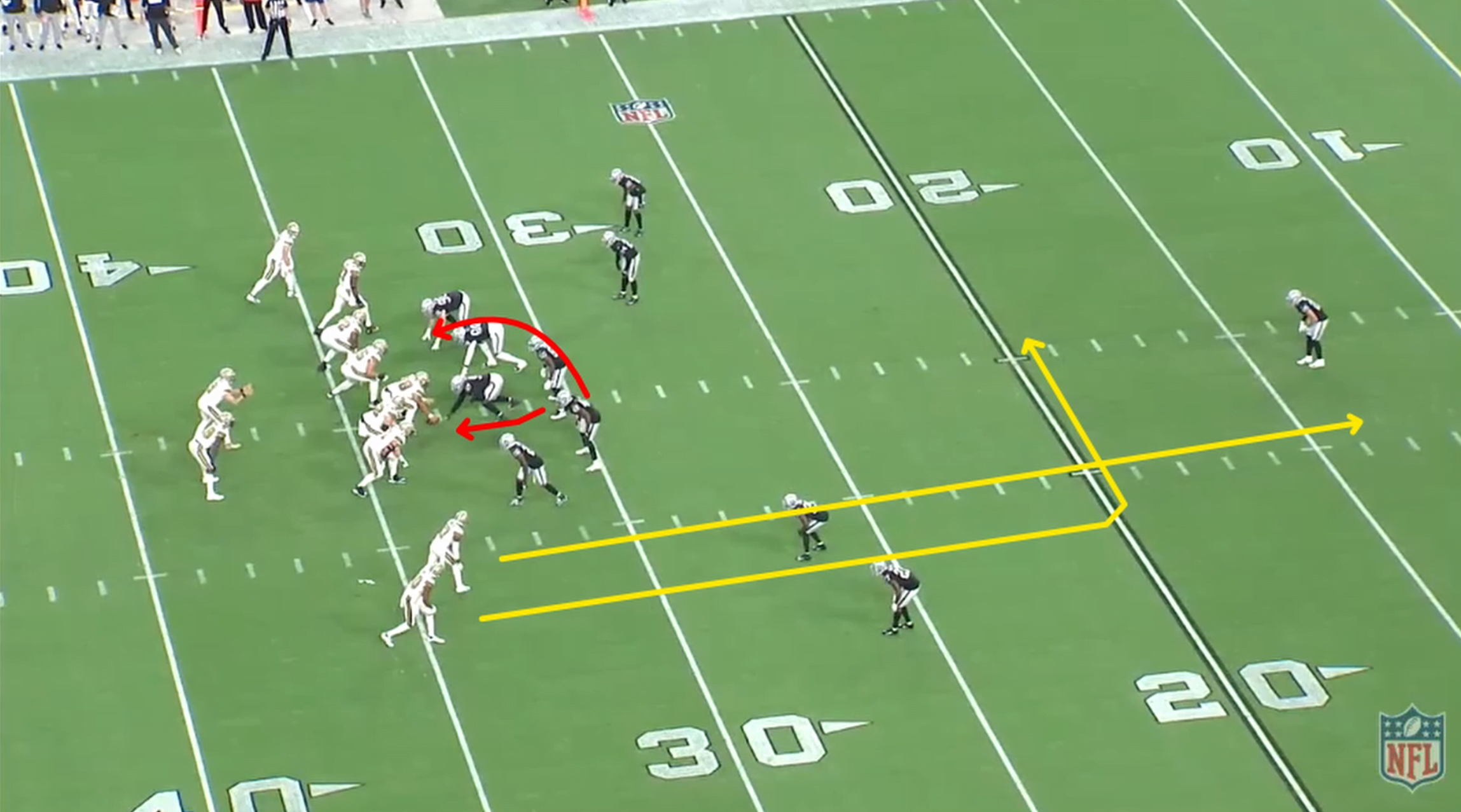

The Saints will run Dagger a couple times a game to attack the middle of the field. The concept stays the same and is effective against whatever coverage they might see. Even if it doesn’t go to the deep dig, it still gets their playmakers in space underneath.

So that’s Dagger. What Sean Payton has started to combine it with though is the Y-Cross concept. Let’s dig into that a little bit and then we’ll see how he meshes the Dagger and Y-Cross into one to add wrinkles to the playbook and give Brees a lot of options on the play. The Y-Cross is run by a lot of teams off play-action and with tight ends but you can run it out of any personnel grouping and off pure drop back as well. Against the Lions, the Saints run it out of 11 personnel with a rocket motion to the field. The tight end, or the Y, has the Crossing route. He is working for an inside release and then across the field and an angle at which he would run out of bounds at 18-22 yards downfield. Against zone, he would settle in the first hole after the Mike linebacker and in man he would continue to run across the field. Behind the Y-Cross, you have a deep dig route similar to what we saw on Dagger. There really are a ton of areas that are possible to settle in for both the Y-Cross and that deep dig route so it can be hard to recognize since it can be run five times and have the receivers all stopping in five different spots on the field. The concept on Y-Cross it is very similar, the Y-Cross pulls defenders and vacates space for the dig coming in behind it. The main difference here is that the outside receiver is running a vertical route and there’s no shallow drag coming underneath it. The first read is always checking for that vertical from the X receiver away from the Y-Cross. The quarterback then works to the Y-Cross, and then the deep dig behind it.
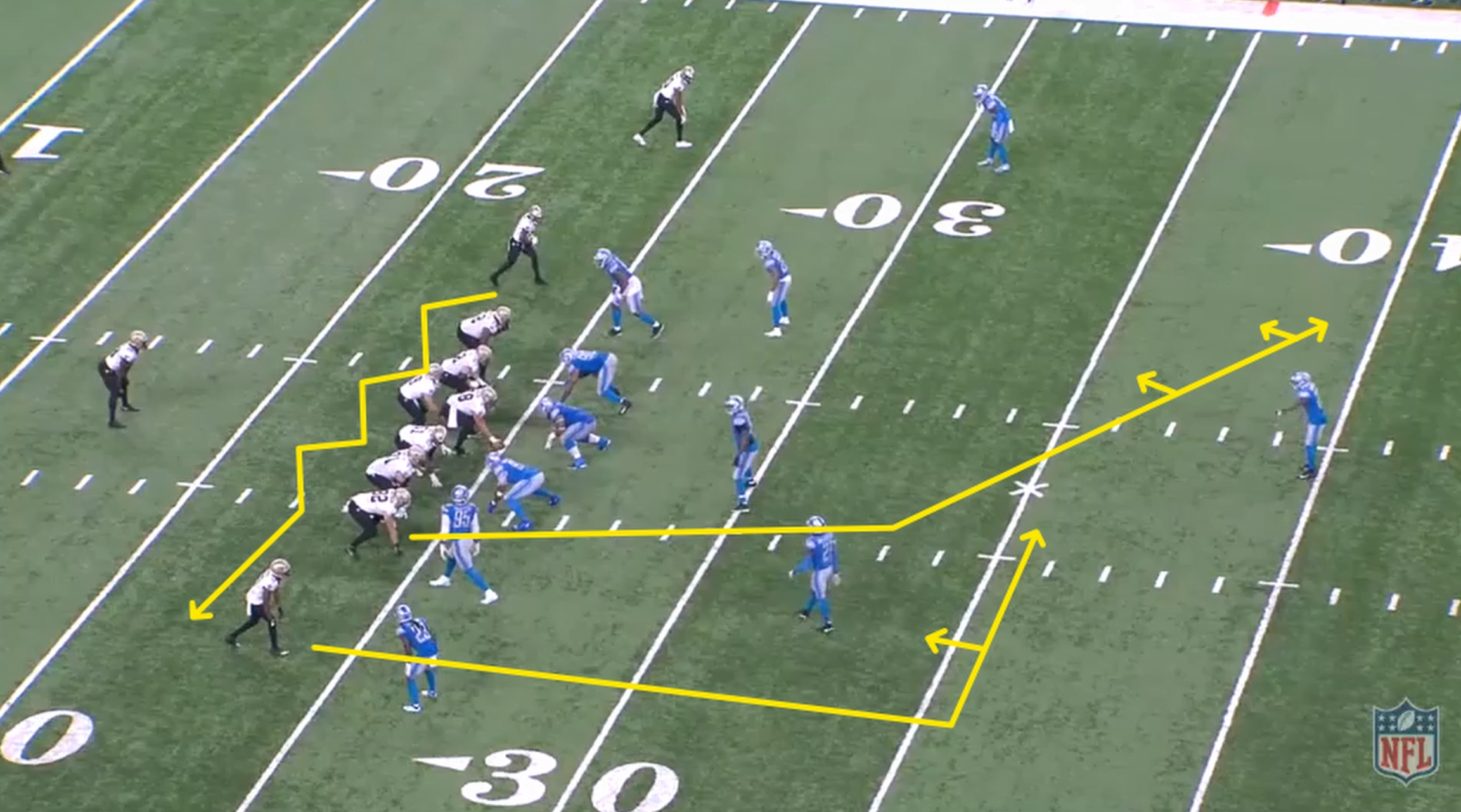

Now on a pure drop back you have the same concept, with the Y-Cross which can sometimes be checked into a hard dig if the receiver is feeling man coverage. You still have the dig behind it and the vertical from the X receiver. Brees could have again had the dig but checks it down to Kamara in the flats and ends up getting good yardage. With all that flow to one side, the Saints like to leak Kamara into the flats into the backside. Again, they’re just getting their best player in space on a linebacker or corner and letting him go to work.
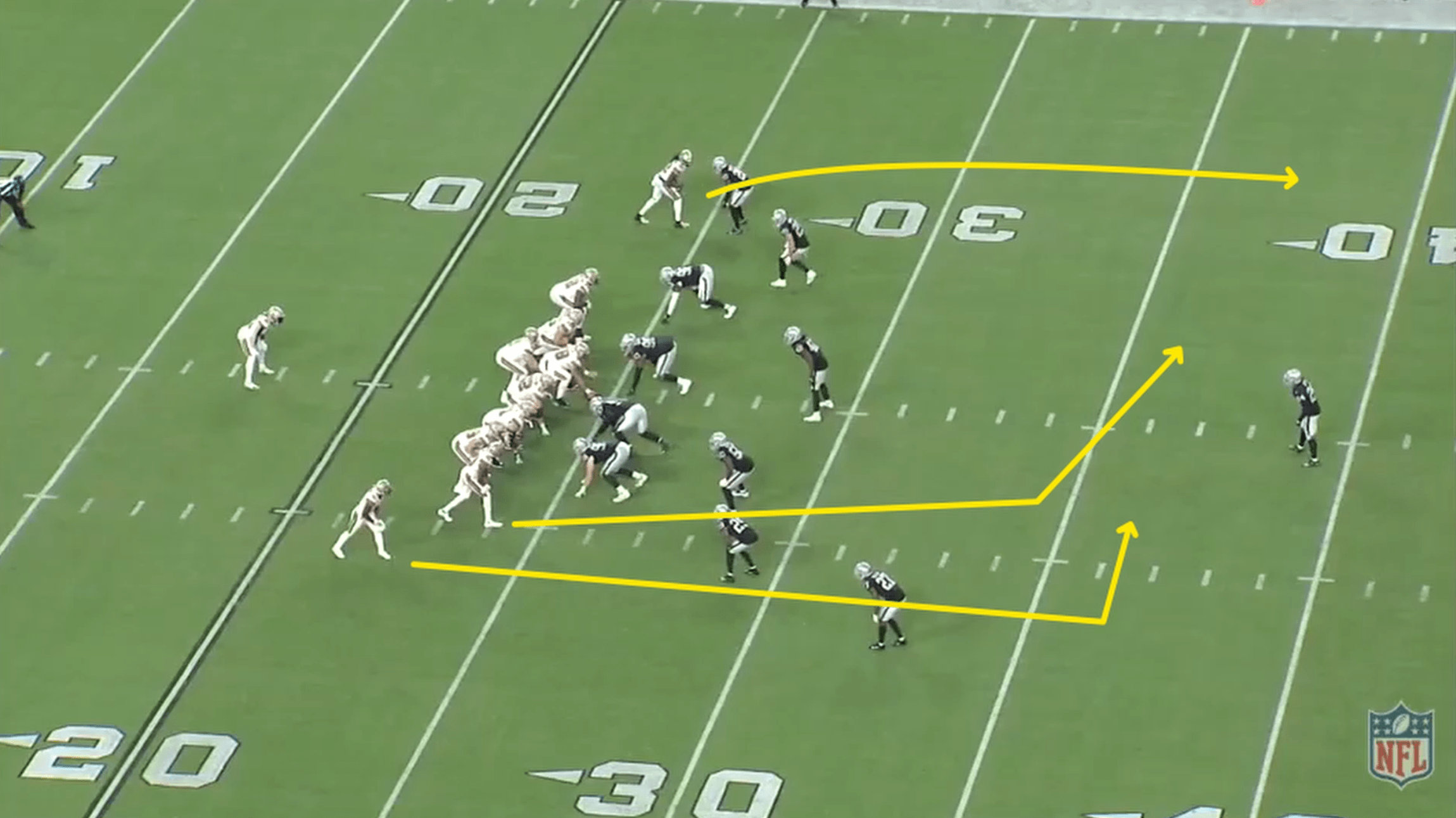

Now that we understand what both Dagger and Y-Cross look like we can look at what the Saints offense does out of trips to combine the two concepts into one play and stress the defense in multiple ways. It’s an easy install into already established plays in the offense and allows versatility for attacking coverages and creating a big play. The Chargers are in a unique defense here where they’re playing man coverage underneath with one true free safety and then two deep seem defenders that are going to sit at the sticks and help bracket players from the outside on this 3rd and 14 from the Saints. The Saints call up their Y-Cross Dagger combination concept out of trips. The #3 receiver runs the Y-Cross, the #2 receiver runs that seam clear out that we saw in Dagger, and the #1 receiver runs the deep dig behind it. On the single receiver side you have the shallow drag that you normally see in Dagger as well. So really it’s just like running a Y-Cross with the additional receiver on the Dagger side when they’re in trips. You have Dagger from the outside guys and the dig plays into the Y-Cross so you’ve managed to combine both concepts. What this does is attack that deep safety with two verticals. If he runs to the Y-Cross, he’s leaving his corner out to dry down the seam, and if he stays with the seam like he does, it puts the linebacker in trail position in an impossible position. That seam defender to the boundary at the top of the screen is supposed to sit and guard the sticks, but if there’s nobody threatening, he has to get deep and underneath the Y- Cross. That player is #44 Kyzir White who plays linebacker. Clearly not a guy that’s used to protecting a deep zone of the field. Brees knows that, and attacks that matchup. If the Y-Cross wasn’t there though, the dig portion of the concept is about to break open in the middle of the field and the shallow drag has pulled out any underneath defenders. The Seam from Dagger concept held the safety to allow the Y-Cross to get open.

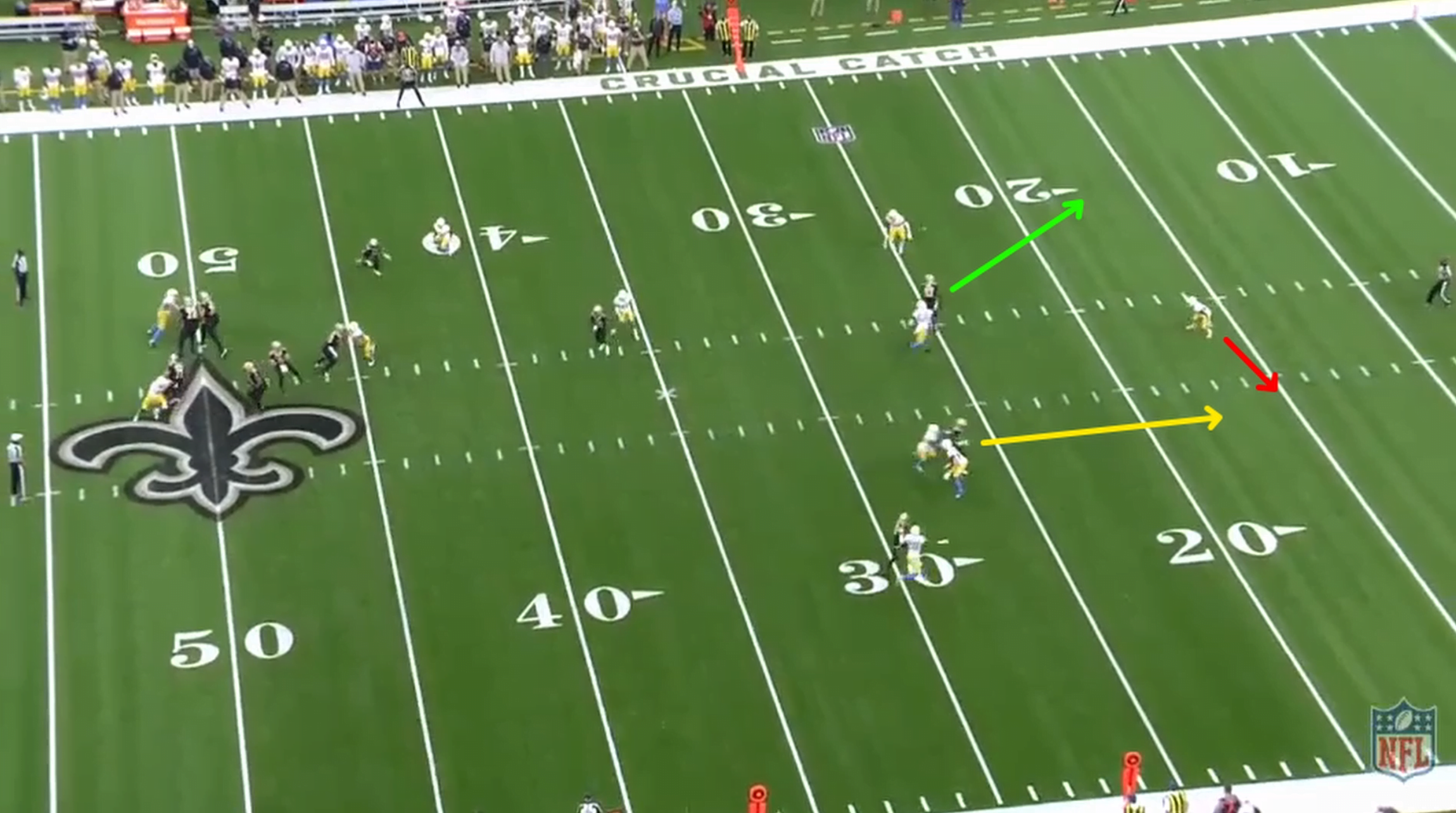

The Saints have run this combo concept a couple times this year. This time, against the Lions, the Seam is the one that’s open. Brees ends up checking it down to the shallow drag to Taysom Hill but let’s take a look at the bind it puts defenses in. The Y-Cross gets the safety’s his hips turned inside and the dig helps bring down the corner. The corner to the top of the screen jumps on the dig and with the safeties hips turned the wrong way, the Seam is open and there’s a ton of space for Brees to throw to. The Y-Cross has taken 3 defenders, the Dig has taken two, and that leaves 1-on-1 matchups for the rest of the routes – the seam, shallow drag, and leak from Kamara. Brees comes down to the shallow drag who settles in the middle of the field but the shot to the seam was there and available for a big play.
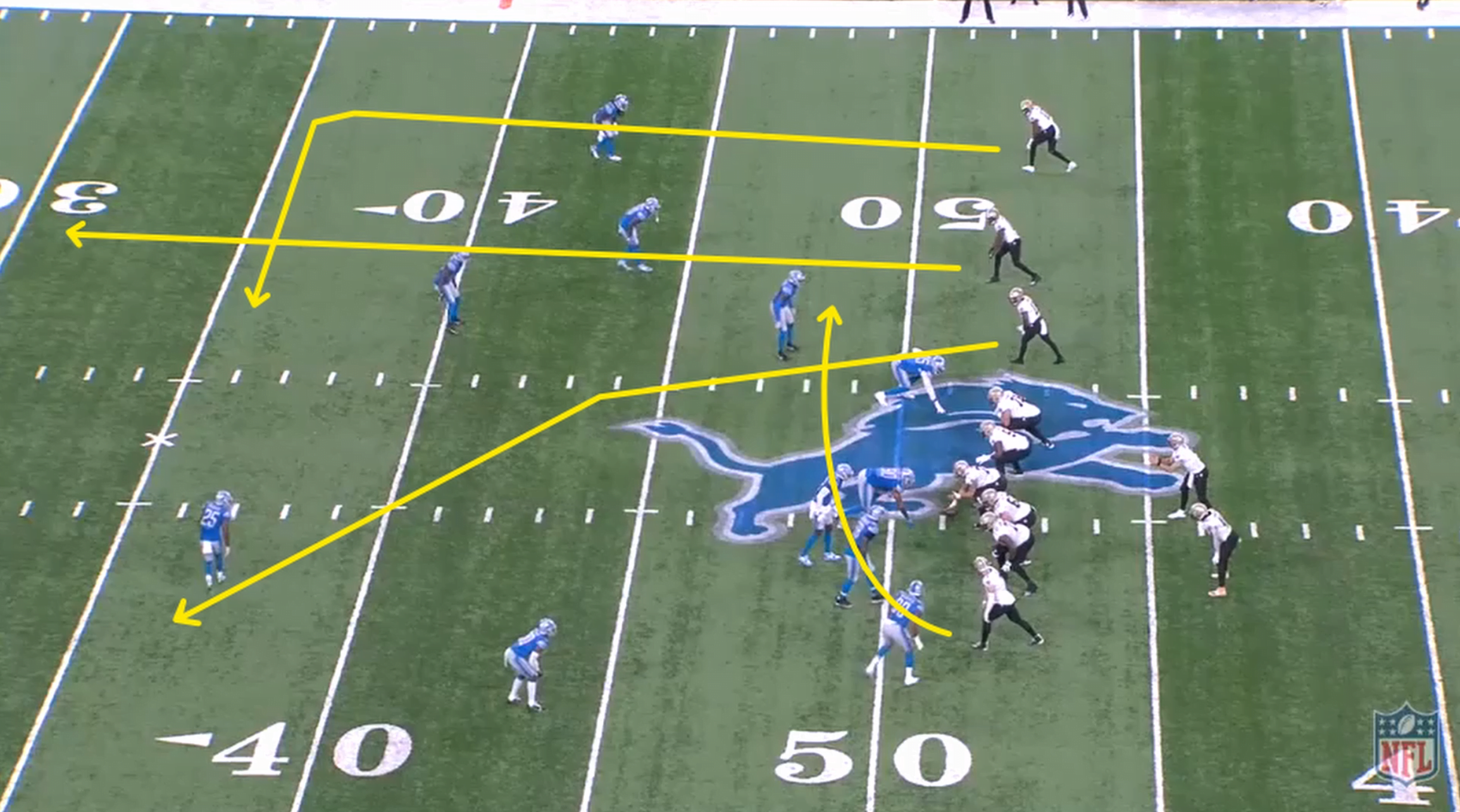

The Saints are right in the thick of things and have managed to survive a stretch without their best weapon in Michael Thomas while still being right at the top of the NFC South. Things are only going to improve for that offense upon his return. Sean Payton does a good job of combining concepts and attacking defenses in multiple ways. It creates easy outlets for Drew Brees and even when they don’t work, they end up getting Kamara into the flats. So, let’s not say Drew Brees is washed and the Saints are done. They’re just fine. With the wrinkles that Sean Payton assuredly has in store, the sky is still the limit for the Saints offense and they can absolutely still compete for a Super Bowl.
If you liked this post make sure to subscribe below and let us know what you think. If you feel like donating and want access to some early blog releases and exclusive breakdown content or to help us keep things running, you can visit our Patreon page here. Make sure to follow us on Instagram @weekly_spiral and twitter @weeklyspiral for updates when we post and release our podcasts. You can find the Weekly Spiral podcast on Spotify or anywhere you listen.
